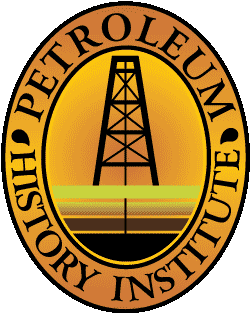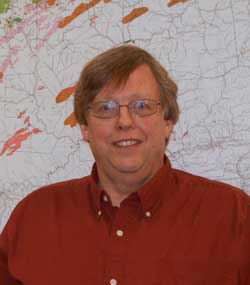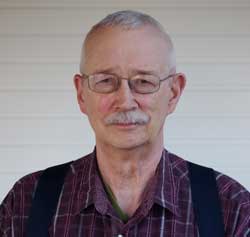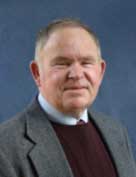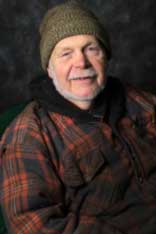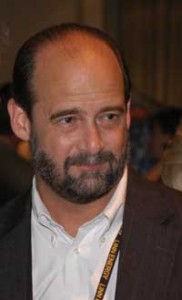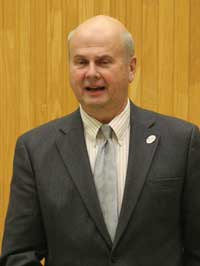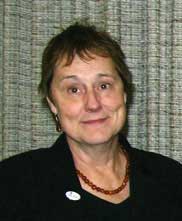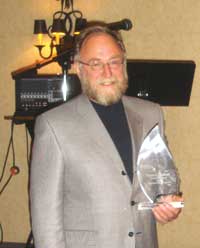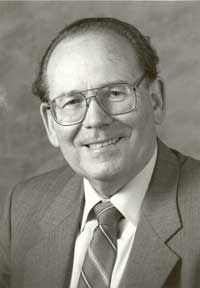Samuel T. Pees Keeper of the Flame Award
“Recognizing individuals who have devoted their efforts to preserving the heritage of the oil and gas industry and bringing before the public the heritage and history of the oil and gas industry”
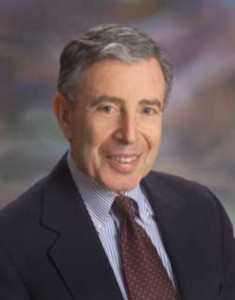
Harvey L. Golubock
Harvey L. Golubock: worked for Witco for twenty-eight years from 1969 until 1997. Over that time he held titles of planning analyst, assistant to the president, assistant to the chairman, VP and General Manager, VP of Corporate Communications, VP Supply and Distribution and finally Group, VP. In 1995 the company made the strategic decision to sell off his Group, which consisted of the Kendall/Amalie Division; the Golden Bear Division and the Southwest Grease Division. By 1997 they had sold off most of the businesses. An entrepreneur acquired the Bradford, PA refinery (the Kendall refinery) and asked Harvey to join his company, American Refining Group, Inc. (ARG), and run the refinery business. It was a turning point in Harvey’s life and both an opportunity and a challenge as all of the marketing assets and the Kendall brand name had been sold previously to Sun Oil Company. Most of the industry gave the ARG six months before they would fold. It can happily be said that Harvey Golubock retired as president of ARG in 2011, after a fourteen-year run. Under Harvey’s leadership ARG reinvented the business and developed as a sustainable entity. It should be noted that the refinery was established in 1881 and is the oldest continuously operating crude oil refinery in the world.
Harvey Golubock spent most of his time during those fourteen years in Bradford, PA, the home of the refinery. In 2006 ARG held a major celebration in Bradford commemorating the 125th anniversary of the refinery, complete with a parade down Main Street and a sign from the State recognizing the refinery as a Pennsylvania historic landmark. They participated in an oil well shoot that commemorated Bradford’s 150th anniversary. Once the refinery back on a profitable keel, Harvey felt that it was important to give back to the local community. Over the years he served as chairman of Beacon Light Behavioral Health (an organization devoted to providing services to mentally and emotionally challenged children and adults) Co-chairman of Bradford Area Alliance ( an alliance of major business people in the Bradford community devoted to economic development of the region); Executive Committee of the Advisory Board and the University of Pittsburgh at Bradford (UPB); Bradford Hospital Foundation Board; Penn Brad Museum Board ( a museum dedicated to preserving the rich heritage of the Bradford crude oil region); Chairman of the Energy Institute at UPB. He has had the pleasure of addressing MBA classes at both St. Bonaventure and Rutgers Universities.
Harvey L. Golubock has been awarded the key to the city of Bradford. He is also a recipient of the Presidential Medal of Distinction from UPB and has a wing in the science building at UPB named in his honor.

Melissa L. Mann
Melissa L. Mann resides in Meadville, Pennsylvania. She has majored in History at every academic level, including her Bachelor of Arts degree in 1998 from Muskingum College in Ohio, her Master of Arts in 2001 from the University of New Mexico, and her Doctorial coursework through 2004 at the University of New Mexico. Shortly after her move to Pennsylvania, Melissa was hired by the Oil Region Alliance as the OIL 150 Deputy Director, a post she held from 2008 through 2010. Upon the completion of OIL 150, Melissa was retained by ORA as Senior Project Manager for Heritage Development in 2011 and again in 2013 as an Interpretive Specialist. In March 2013 she was selected by the Pa. Historical and Museum Commission to become the Site Administrator for three of oildom’s key historic sites and facilities – Drake Well Museum and Park, Pithole, and McClintock Well #1. In these professional capacities, Melissa has written numerous technical and popular articles and publications, assisted documentary filmmakers, coordinated new historical markers, developed many educational materials and programs, organized symposia and workshops, escorted media representatives in Oil Creek valley, and been interviewed by quite a few broadcasters. Through each of these methods, she strives to portray accurate information and related references in clear, objective ways to assist listeners of all ages to understand and value the heritage and history of the oil and gas industry.
Al began his professional career as a chemical engineer in 1951 and he has done extensive work in the energy industry. His first job out of college was with Shell Chemical Corporation in California. In 1957, he joined Gulf Research & Development Company in Pittsburgh, where he worked until 1983. Subsequently Al worked for the U.S. Department of Energy in Pittsburgh and continues to do energy-related contract work. Over the past few years he has developed an interest in history, and has become fascinated with the development of the worldwide petroleum industry, which had its origins in Western Pennsylvania. Al is a member of the local section of the American Chemical Society (ACS), and coordinated the research project on the origins of the petroleum industry, which resulted in the national ACS awarding two plaques as part of their Historic Landmark program: one at the Drake Well Museum in Titusville and the other, commemorating the pioneering work of Samuel Kier, mounted on the wall outside the U.S. Steel Tower on Seventh Avenue at Grant Street in Downtown Pittsburgh. He has authored several history papers and was a co-author of a book on the history of the East Liberty section of Pittsburgh, and currently he is the President of the East Liberty Valley Historical Society in Pittsburgh.
John started his geology career in 1973 and 1974 as a summer intern with the Oil and Gas Geology Section of the Pennsylvania Geological Survey in Pittsburgh while working toward a Ph.D. in paleontology. In November 1977, upon finishing his degree, he joined the staff of the Pittsburgh office full time to work with a multistate research team studying Devonian organic-rich shales as part of the U.S. Department of Energy’s (DOE) Eastern Gas Shales Study. In April 1981, after all the senior geologists left to pursue jobs in industry or academe, he was kicked upstairs and headed the Pittsburgh office for the next 28 years.
John was integrally involved in nearly all aspects of the daily routine and special research projects carried on in the office. He and his staff participated in many studies dealing with subsurface and petroleum geology, geochemistry, and geophysics, including numerous projects funded by DOE. Over the years, John developed a keen interest in the history of petroleum geology, drilling, and production, beginning with the first commercial gas well (a shale-gas well!) in North America, dug at Fredonia, NY, in 1821. He feels that he comes by his interest honestly. Many of his ancestors lived within the limits of the McDonald oil field in southern Allegheny County, PA, including some “extended family” relatives named Mevey (pronounced mah-Vay) on whose lease Greenley and Forst drilled the second largest oil well in the Appalachian basin in 1891 (IP – 18,000 BOPD from the Gordon sand, Venango Group, Upper Devonian).
Over the years, John published numerous articles, both popular and professional, that often highlighted petroleum history, including: 1) biographies of John F. Carll, Samuel W. Kier, and Israel Charles (I. C.) White; 2) an exploration, drilling, and production history of Lower Devonian Oriskany Sandstone gas fields in the Appalachian basin, including the very large Leidy gas field in Cameron and Potter counties, PA; 3) historical sites around northwestern PA, such as the Drake well, Pithole, Warren County oil and gas fields, and the #1 McClintock well; and 4) historical markers about petroleum in Crawford, Venango, and Warren counties, PA. A major highlight of his career occurred in 2007 when the Oil Region Alliance, Inc. and the Drake Well Museum asked him to write the justification and citation for a historical marker commemorating his hero, John F. Carll. He also helped unveil the marker in Pleasantville, Venango County, PA, that year.
In April, 2009, John was kicked upstairs once again, overseeing not only the oil and gas office in Pittsburgh, but also the mineral resource analysis group in the main Survey office in Middletown, PA. He remained in that position until he retired at the end of December, 2012.
John’s reputation as something of an expert on a variety of Pennsylvania and Appalachian geology topics followed him into retirement. He volunteers some of his time at the Survey working on projects and providing basic information on oil and gas, geologic hazards, fossil collecting, and Pittsburgh-area and western Pennsylvania geology to both Survey staff and anyone who finds the Survey a gold mine of free geological information. Outside the Survey, John is a longtime member of the Board of Directors of the Pittsburgh Geological Society, volunteers some of his time with the Invertebrate Paleontology Section of the Carnegie Museum of Natural History, serves on the organizing committee for the 2013 AAPG convention in Pittsburgh, sings Tenor I with the 100+-voice Pittsburgh Concert Chorale, and enjoys playing with his 3-year-old grandson, Peter.
Carl Heinrich is a Pennsylvania native who spent his early years in Allegheny and Warren Counties. This exposure to wells producing from the shallow Venango sand oil zones led to a future career in the field. Enlisting in the brown shoe peacetime Army at the age of 17 ½ was a rite of passage for teenagers of the period. After service he spent several nomadic years working in the Pennsylvania, New York, Ohio and West Virginia oil fields as a cable tool rig tool dresser, rotary roughneck, oil and gas well tender, compression station operator, pipeline walker, well site geologist, etc. Finally getting smart and realizing there was more to the industry than the dumb end of a sledge handle or a wrench, he graduated from Marietta College in 1964 with a dual B.S. degree from the Petroleum Engineering and Geology Department. His first job after college was with a small consulting firm, Well Supervision Inc., in Mt. Gilead, Morrow Co., Ohio (the last of the old time town lot drilling booms). He served as district engineer for Quaker State in Parkersburg, WV from 1970 – 1978. This district covered all of Ohio except for one county, southwestern Pennsylvania (McDonald Field) and part of Kentucky. At that time Quaker State was the closest thing to a major company in the Appalachian area and it was professionally rewarding to work and study the geology of the Appalachian area. Since 1978 he has been gainfully unemployed as a producer and consultant for his own account and for various clients. With his wife, Judy, as a business partner his companies have developed prospects and production in Ohio, Pennsylvania and West Virginia. Currently his daughter Christy and her husband Brian Chavez are active in leading the companies into the future.
Beginning in 1968, he pioneered deep drilling in Southeastern Ohio expanding the development of reserves from Berea to Devonian shale, Marcellus, Oriskany, Clinton-Medina, and Utica. In 1978 Carl developed and instituted the all gas nitrogen fracking completion technique and co-authored a SPE paper on the subject. In 1978 he was a founding member of Southeastern Oil and Gas Association (SOOGA) and still serves as a board member as well as co-editor of SOOGA Insider newsletter. He has also served as a board member of Ohio Oil and Gas Association (OOGA), API oil reserve committee, AAPG, AAPL, IOGA WV, Society of Petroleum Engineers (SlPE), Pi Epsilon Tau (petroleum engineering honorary society at Marietta College), and Ohio Geological Society. Always a student of history, he specializes in oil field history and has been associated with Drake Well Museum (collection committee) and Parkersburg WV Oil, Gas and Industrial Museum (board member).
Carl and Judy live in an 1894 farmhouse near Reno, Ohio, where they raised two children, Joseph and Christyann. Eighteen Cow Run sand oil wells on the farm paid for its original construction. The original house and its additions in 1978 and 2002 were all paid for with oil money, so it has housed oil field trash for the last 119 years. At one time it was an oil field boarding house and neighborhood rumors suggest it might even be haunted.
(Material above provided by the Heinrich family)
Additional Comment by Jeff Spencer: When I asked Kathy Flaherty to provide a comment about her friend Carl, both she and her husband Tom mentioned the Heinrich hospitality and Carl’s eagerness to share his knowledge of oil field history. Not surprisingly, I experienced that same hospitality the first time I visited Carl and Judy. I was at Marietta College researching material for Ohio Oil and Gas. When I stopped by to talk to Professor Chase, he suggested that I talk to Carl and he arranged for a visit. Carl allowed me to look through a box of old photographs and to scan several. I was then invited to stay for dinner. Later, when I was further along with the book, I contacted Carl several times to tap his knowledge of early oil field equipment. Chapter One of Ohio Oil and Gas contains many of Carl’s images and the captions include much of what he shared with me. I also have a “Carl Heinrich file” where I keep copies of his Southeast Geology articles from SOOGA’s (Southeastern Ohio Oil and Gas Association) The Insider newsletter. These articles on Ohio stratigraphy and oilfield history are a great historical source! Lastly, when Rhonda Reda and I were planning the 2011 Oil History Symposium in Marietta, there was little doubt that we would ask Carl to help with the fieldtrip and Carl came through with some choice stops!
Dr. Charles A. Sternbach led his first geology field trip 30 years ago while a graduate student of Dr. Gerald M. Friedman, (Rensselaer Polytechnic Institute: M.S. 1981, PhD 1984; BA Columbia University 1980). Charles worked as a Staff Geologist at Shell (1984-1997) and led field trips with Dr. James Lee Wilson in the 1990’s. Charles explored the US and Europe for carbonate reservoirs and reefs with Tom Jordan (1997-2004). For the past 7 years he has sought (and occasionally found) shallow oil and gas as an independent geologist (President First Place Energy and Star Creek Energy). His companies have several wells producing from Paleozoic reservoirs: (http://www.starcreekenergy.com/).
A Past President of the Houston Geological Society (1999-2000) and an Honorary Member of both HGS (2006) and AAPG (2011), Dr. Sternbach has been recognized for originating and organizing the enduring programs: “Legends” panels at HGS meetings and “Discovery Thinking” forums at AAPG Annual Conventions. Dr. Sternbach founded the AAPG 100th Anniversary committee to celebrate AAPG’s big anniversary in 2017 (chairman 2004-2010). He edited an AAPG special publication: “Discoverers of the 20th Century—Perfecting the Search” with Marlan Downey and Gerald Friedman (2005). He also edited an AAPG DPA publication “Heritage of the Petroleum Geologist” (2002). He is president of the AAPG Division Professional Affairs (2012-2013). His HGS Presentation: “Petroleum Resources of the Great American Carbonate Bank” (2011) is available on youtube.
He married fellow geologist Linda, 29 years ago. Charles likes to say he has three degrees in geology and is married to two more. Their first date was a geology field trip in upstate NY.
A 1965 graduate of Marquette University with a BA in Liberal Arts, Mr. McElwee served for five years as a commissioned officer in the United States Navy. He then accepted a position as an Industrial Trainer and Employee Development/Organization Development Specialist with the Columbia Gas System and, later, with Jones and Laughlin and its successor, LTV Steel.
Mr. McElwee is a student of early oil history and is recognized as a competent oil historian and lecturer. His published work, Oil Creek…The Beginning (2001) presents the lives and times of the early oil pioneers along Oil Creek, most of whom were forgotten by the more popular histories of the period. This work was the result of historical research Mr. McElwee did to successfully nominate Jacob J. Vandergrift for a Pennsylvania Historical and Museum Commission historical marker which was erected in Oil City. This work was the basis of a lecture given by Mr. McElwee at the Drake Well as part of that institution’s historical lecture series.
He previously served on the Board of Directors and was an officer of the Oil Heritage Region, Inc. He currently serves as an officer on the Board of Directors of the Oil Region Alliance of Business, Industry & Tourism. He is a member of the Oil City Council and also the Venango County Planning Commission.
Mr. McElwee is the author of several additional books about the early history of the oil and gas industry in Pennsylvania and is a frequent lecturer on historical subjects with an emphasis on the personalities and enterprises that shaped the beginning of the modern industry. Among his other books are: Standard Oil Co. Men in the Early Oil Region (2006), and The National Transit Co., Standard Oil’s Great Pipeline Company (2007). Mr. McElwee has investigated the life and business activity of oil industry founder George H. Bissell, which again resulted in the Pennsylvania Historical and Museum Commission recognizing Mr. Bissell with a marker in Franklin. Mr. McElwee has given a number of lectures on Mr. Bissell and his impact on the oil industry. He is currently working on a new book based on this research, George Bissell, the 19th Century’s Oil Patriarch.
Mr. Huber is one of approximately 50 independent oil producers who pump in the Oil Region National Heritage Area of Pennsylvania. At 70 years of age, he has lived his entire life in Plumer, Pennsylvania, a village approximately 10 miles south of the spot where Edwin Drake struck oil in 1859. Mr. Huber is a third-generation independent petroleum producer. His family entered the business in the mid-1860s when Plumer, then known as Plummerville, was at the center of an oil boom in the Cherry Run Valley. Mr. Huber’s paternal grandfather, also named William Huber, started in the industry as a standard rig builder. Later, Grandfather William Huber and his only child Herbert worked as well drillers throughout the Oil Creek Valley while also pumping wells on their own property.
By the time he was 20-years-old, Mr. Huber had inherited his family’s extensive and historic lease. Using both modern and nineteenth century methods and equipment, he manages over 100 stripper wells, including the Weber No. 1, a well that his grandfather drilled in 1865. In addition to producing oil, Mr. Huber has done a great deal to preserve the heritage of Pennsylvania’s early petroleum industry. Over the years, he has generously volunteered his time and knowledge to help produce new oil heritage programming. For example, Mr. Huber’s contributions to the ORA’s documentary The Valley that Changed the World, produced in 2009, were invaluable. The film has been telecast 288 times on 104 stations across the U.S., and every time it is screened, hundreds of people get the chance to hear Mr. Huber discuss the history of Pennsylvania’s independent production and to see him operate his nineteenth century equipment. To date, Mr. Huber’s most significant contribution to the preservation of oil history was his participation in the Oil Region Alliance’s 2009 oral history project entitled Stories of a Third-Generation Independent Oil Producer, As Told by Bill Huber; a 25-minute educational film which has been distributed to Pennsylvania’s 650 public libraries and to 250 museums across the U.S.
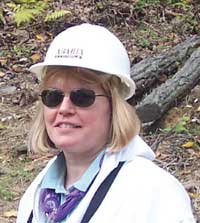
Kathy J. Flaherty
Kathy J. Flaherty is the current editor of Oilfield Journal, published by Friends of Drake Well, and a member of the Editorial Board of Oil-Industry History. She is a member of PHI and Friends of Drake Well. She holds a Bachelor’s degree in Geology from S.U.N.Y. Binghamton and a J.D. from Duquesne University in Pittsburgh, PA. Ms. Flaherty is employed as a petroleum geologist for ABARTA Oil & Gas Company in Pittsburgh, PA. Oil history is her hobby and she is often found roaming the hills of western Pennsylvania, accompanied by her husband Tom, searching for artifacts from our petroleum past. Ms. Flaherty has contributed many articles and poems to this journal and other publications devoted to the history of the oil and gas industry.
Tom Fulton began his geophysical career after receiving a BS in Physics from the University of North Texas in 1951. Following seismic work in Venezuela, he completed a MS in 1955. His professional experience spanned technology changes from 8 trace split spread marine paper records to specification of digital processing and finally to 3-D processing quality control. His employers included GSI, Amoco, King Resources, Gulf, and Chevron. Tom also started Seismic Solutions, Inc. to provide seismic processing services to the industry. Tom was a member of the Geophysical Society of Houston from 1972 until his death in 2009, and his service included Chairperson of the Museum Committee, Luncheon Speakers Coordinator, Chairperson of the Data Processing Special Interest Group, 2nd Vice President, First President-Elect and President. He was a 55-year member of the Society of Exploration Geologists (SEG) and his service included work with the Technical Standards Committee (Polarity), Program Chairman for the Second Annual Gulf Coast Meeting and Chairman and longtime-member of the SEG Program Committee of the Offshore Technology Conference. Tom was also the principal organizer of the Living Legends event featured at yearly SEG Conventions. He was a frequent contributor to Oil-Industry History, and often provided very interesting displays of early geophysical equipment at the annual PHI symposia. Tom Fulton died in 2009.
PHI is pleased to recognize the many contributions to the maintenance and preservation of the oil and gas heritage that, Susan Beates, has made as Historian/Curator II at the Drake Well Museum Archive. Ms. Beates received her degrees in history from West Virginia University and part of her work their included an internship at the Drake Well Museum. She spent one summer conducting an industrial archaeological survey of the Windy City Air Lease outside of Kane, Pennsylvania, documenting the use of steam engines on those leases. After several years of employment with the West Virginia Regional & History Collect at WVU and the Erie County Historical Society (Erie, Pennsylvania), she returned to the Pennsylvania oil region in 1998. Since then she has re-immersed herself in oil history documenting and cataloging the thousands of items in the Drake Well Museum & Park collections. She is the author of numerous articles related to rural life in northwestern Pennsylvania and the early oil industry there. She enjoys rediscovering the many treasures of the Pennsylvania oil patch.
Marilyn Black is the Vice-President for Heritage Development for the Oil Region Alliance of Business, Industry and Tourism (Oil City, Pennsylvania) where she administers the Oil Region National Heritage Area. She earned a B. A. in education and sociology from the University of Pennsylvania, and she has an MBA from the Pennsylvania State University. She and her husband, Darl Black, resided in Cochranton in Crawford County.
Bruce Wells is the Executive Director of the American Oil & Gas Historical Society (AOGHS), a non-profit organization founded in 2003. He accomplishes the Society’s educational mission by publishing a quarterly newsletter, The Petroleum Age, reviving the name of a monthly oil industry publication of the 1880s. Mr. Wells also maintains the Society’s web site, is a sought after speaker on early oil history for industry gatherings and community events. The Society also hosts conferences and fieldtrips which focus on oil and gas museums and their contributions to the preservation of the oil and gas heritage of our nation and educating the public of that heritage.
Will Wingo is the Director of the Oil 150 Committee for the Oil Region Alliance of Business, Industry and Tourism. He is charged with fostering the discovery and appreciation of our nation’s oil heritage and its roots in the Oil Region National Heritage Area; specifically leading up to and through the 150th anniversary of the Drake Well which is celebrated in 2009. Mr. Wingo received his Bachelor of Arts degree from Alfred University, Alfred, New York, and was formerly employed by KBR/Halliburton in Iraq. He also was employed at the Titusville Hospital and the Commonwealth of Pennsylvania. His hobbies include rebuilding and restoring vintage Mack Trucks and gas engines, like the Reid Engines, that were used in the oil fields of Pennsylvania.
Barbara Zolli is the Director, Drake Well Museum & Park, the Commonwealth site where Edwin Drake’s well launched the modern petroleum industry in 1859. In addition she also oversees the Pithole Visitor Center and the McClintock Oil Well #1 for the Commonwealth of Pennsylvania. The McClintock Well #1 is the world’s oldest continuously pumped oil well. Ms. Zolli earned her undergraduate degree from the Massachusetts College of Art in Boston and completed the Cooperstown Graduate Program in Museum Studies requirements toward a Master’s degree from the State University of New York. She resides on the grounds of the Drake Well Museum & Park near Titusville, Pennsylvania.
Charles Oliver Fairbank, III is the fourth generation to work the family oil fields near Petrolia, Ontario. Although he did not start out to be in the oil business, after taking a degree in biology (University of Western Ontario) and studying history at Concordia University in Montreal, in 1969 Charlie decided to return to the Fairbank oil field. Once there, he was hooked, even though his father, Charlie, Jr. warned him that he needed to find some other way of spending his life. Heeding his father’s advice, young Charles obtained a teaching certificate and taught secondary school for several years, but the draw of the oil fields was too great, and with the oil embargo of 1873, he returned home. According to the Fairbank story (The Story of Fairbank Oil…, by Patricia McGee [Charlie’s wife]), he is the first Fairbank in a while to actually work in the fields, and he has maintained, rebuilt, refurbished, and no doubt cussed at, the old equipment, some of which was put in place by his great-grandfather, John Henry Fairbank. Charlie still pumps oil with jerker-rod systems and central powers; about the only change are the electric motor in the place of the old Reid, Franklin, or similar gas engines. He has allowed the Canada Oil Museum to treat his property as a living museum, which it is, and he has been a very active supporter of the Museum.
The Petroleum History Institute is pleased to recognize the efforts of CHARLES OLIVER FAIRBANK III with the 2008 SAMUEL T. PEES KEEPER OF THE FLAME AWARD for maintaining the heritage of Fairbank Oil operating into the fourth generation and for allowing his property to be a living museum of oil heritage for the many visitors to the area.
Earle Gray was editor of Oilweek magazine in Calgary for nearly 20 years. In the 1970s he was director of public affairs for Canadian Arctic Gas, a consortium of major oil and gas companies that planned and researched a multi-billion dollar gas pipeline from Alaska’s Prudhoe Bay and the Mackenzie River delta and Beaufort Sea in the Canadian Arctic. He is a former publisher, editorial consultant and speechwriter. He is the recipient of numerous business writing awards, including a lifetime achievement award from the Petroleum History Society (Canada). He is the author of eight books about the energy industry: The Great Canadian Oil Patch (1970), The Impact of Oil, The Great Uranium Cartel, Wildcatters, Super Pipe, and Forty Years in the Public Interest, a history of the National Energy Board, as well as editor of and lead contributor to Free Trade, Free Canada. The second edition of The Great Canadian Oil Patch: The Petroleum Era from Birth to Peak, was published in 2005. Ontario’s Petroleum Legacy: The birth, evolution and challenge of a global industry (2008)tells how it was Canada that gave birth to today’s petroleum industry, relates its the growth in Canada, and outlines the challenge that confronts the industry in the era of global warming.
The Petroleum History Institute is pleased to award EARLE GRAY the 2008 SAMUEL T. PEES KEEPER OF THE FLAME AWARD in recognition of his efforts to keep the history of the Canadian oil industry alive and in the public eye.
Lois McElwee, formerly with the Oil Region Alliance for Business, Industry & Tourism (Oil City, PA) and former Sesquicentennial Coordinator for the Drake Well 150th Anniversary. As director of the OIL 150 Committee she provided contract services for the Oil 150 project that creates awareness of the 150th anniversary of the Drake Well and the birth of the oil industry. Her functions included representing Oil 150 throughout the nation, managing the development of the awareness plan, the feasibility study, the logo, fundraising campaign, and the www.oil150.com website. Functions include writing grants, communicating with potential donors and the public, organizing meetings and agendas, building community support, publicly representing the Oil 150, coordinating and motivating volunteers, and creation of collateral materials and publicity.
She developed and implemented a Master Plan, worked with advertising and marketing firm to develop a national awareness plan and marketing plan. She participated in the feasibility study and the funding campaign plan development for the Oil 150, and successfully solicited donations to help fund the Committee’s activities. And she was involved with development of the educational website and administering the www.Oil150.com website. Among her successful grant applications was one for the creation of a documentary film, due for completion in early 2009, devoted to early oil history of the region.
She has promoted the Oi150 celebration nationally through press releases, on the Internet, presentations at conferences and conventions, and formal press conferences; made presentations to energy education leaders, oil industry businessmen, government representatives, and general public. Oil 150, through her leadership, has participated at the Petroleum History Institute Symposia, The American Oil & Gas Association’s Energy Education Conference, and the Pennsylvania League of Cities and Municipalities. She has arranged for articles about Oil 150 to appear in the Petroleum Age, the American Association of Petroleum Geologist’s Explorer magazine, Online Oil, and on Yahoo.com.
The Petroleum History Institute presents the 2008 SAMUEL T. PEES KEEPER OF THE FLAME AWARD to LOIS McELWEE for her efforts to promote the 150th anniversary of the Drake Well and the subsequent development of the modern oil industry in the United States and the world. The award was presented at the May meeting of the Oil 150 Committee in May 2008 by William Brice, Editor of Oil-Industry History.
JoAnn Cowans’ work covers a wide range of subjects and techniques. She is best known for her oil field paintings. A B.A. degree in art from Barton College was followed by post graduate work at University of North Carolina School of Design, UCLA, Otis Art Institute and extensive study with Carlo Buonora in classical portraiture and painting techniques. In the early 60s she painted the Venice, California oil fields as they were being dismantled during the construction of Marina del Rey. Her show, By The Speedway’s End, documented the passing of old Venice and Playa del Rey. The presentation was a smashing success. Most of these paintings are now in private collections. In 1993 she moved to Orange County in California. Her home there overlooked another oil field. Bastanchury Oilfields is a view from her studio window. Later, when the bulldozers came to clear the field of pumps and equipment, she moved again. This time it was close to the Brea oil fields. Here she paints the last derricks in southern California. A retrospective exhibit of her oil field paintings opened July10, 2003 at the Muckenthaler Museum and Cultural Center in Fullerton, California. That show was extended twice, by popular demand, to run through the end of the year. Here work is in many corporate and museum collections and has been written about in The Wall Street Journal, Upstream Oil and Gas Newspaper, The American Oil and Gas Historical Society, Petroleum Age and The Los Angeles Times. JoAnn reproduces her paintings in Giclée prints. These may be seen on her website, www.blackgoldprints.com. Future plans include an exhibit of oilfield paintings and tracking down the paintings of the Venice field sold to private collectors for a retrospective show and book.
Jack Rider was the owner and publisher of Pacific Oil World magazine, established as California Oil World in 1908 in Bakersfield. During this time Jack served as Director of the Los Angeles Chapter of the American Petroleum Institute (API), honorary life member of Phi Epsilon Tau, National Petroleum Engineering Honor Society, Director of Los Angeles Business Marketing Association and Chairman of the Southern California Magazine Representatives Association. He remains active as a longtime Director of Pyles Boys Camp, a year round program for under privileged boys 12-14 years in age, in oil producing areas, an organization started by an oilman in 149 and primarily funded and ran by volunteers from the oil industry. In 1993 President George Bush visited the camp to make it one of “the high “Points of Life”. Jack is a member of the Wildcat Committee in its 83rd year of producing the HI-Jinx Show, an oil industry spoof, to raise funds for Pyles Camp. Jack is also Chairman of the ”OL” oiltooller Advertisers. Jack is a Californian raised in Delano near the oil boom town of Bakersfield and a 43 year resident of Brea, the site of the old time Brea-Olinda oil field. Jack is a graduate of Bakersfield Junior College and the University of Southern California, and a United States Army Veteran.
Clifford W. Stone has distinguished himself as a strong civic leader not only in his community but also to the Kansas Oil Museum. As Board of Directors Vice President of the Butler County History Center and Kansas Oil Museum, he has been of primary importance in preserving the heritage of the oil industry in Kansas. In 1962, Clarence Rice, Vice President of Marketing for El Dorado Refining Company (El Reco), told Stone: “There ought to be an oil museum at El Dorado, it’s the logical place, and you young fellows will have to do it.” Stone actively pursued that vision. This led to the creation of the Kansas Oil Museum, featuring 10 acres of exhibits devoted to Kansas’ early oil industry and “Our Kansas Oil & Gas Legacy Gallery” honoring individuals who have been significant in the petroleum industry. Through his financial support and personal time, Stone has single-handedly helped the Kansas Oil Museum pursue excellence and growth. With a goal of making the Kansas Oil Museum one of the finest educational facilities in the nation, Stone hopes to advance Kansas’ significant and historical role in the petroleum industry. Clifford Stone’s diligent service, boundless energy and enthusiasm for his community and the petroleum industry is a worthy example and inspiration to others, and has earned him the 2006 Keeper of the Flame Award.
Clifford W. Stone was born in El Dorado, Butler County, Kansas in 1918, the son of Wilber Ernest and Olive Clifford Stone. William Emanuel Stone, Clifford’s grandfather, came to Butler County from Berlin, Germany in 1879 and became one of El Dorado’s wealthiest citizens. Clifford attended El Dorado schools and graduated high school cum laude. Stone attended Kansas State College at Manhattan and graduated with honors in 1939 with a Bachelor of Science Degree in Agriculture. The year following graduation, he returned to El Dorado upon the death of his father to become a partner with his mother in the operation of the Stone farms in Butler, McPherson and Finney counties. Later, the mother/son team would purchase and operate the Walnut Valley State Bank in El Dorado. Mrs. Olive Clifford Stone believed that happiness lay in serving others and she imparted this philosophy to her son.
Clifford married Sara (Sally) Lou Connell, of El Dorado, on December 10, 1941 and several months later, in April 1942, he enlisted as an aviation cadet with the U. S. Army Air Corps. The nation had been at war only four months. Stone, a young man in his early twenties, served as a B-24 pilot with the 763rd Squadron of the 460th Heavy Bombardment Group of the 55th Wing of the 15th Air Force in the European theater of operations in Italy. While participating in his 50th credited bombing mission, his B-24 was shot down. He was captured by the Germans and spent the remainder of World War II at Stalag I prisoner-of-war camp. His military decorations include the Distinguished Flying Cross and the Air Medal with three Oak Leaf Clusters. At the time of his separation from active duty, he was a captain, but he later attained the rank of major in the U. S. Air Force Reserves. Clifford and Sally have two children, Samuel C., a practicing attorney in Tulsa, Oklahoma and Sue Hunter of Kansas City, Missouri.
After the war, Stone became the Managing Director of Saco Oil Company and the Yuma Oil Company, positions he held for the next 26 years. Both companies had been owned since 1934 by Stone’s father-in-law, O. J. Connell. Saco and Yuma had producing leases in Butler, Marion, Russell and Sedgwick counties, Kansas as well as interests in Texas and Oklahoma. Adhering to his belief in the importance of being a good corporate citizen, he saw to it that both oil companies actively supported all civic and county endeavors in addition to furnishing labor and supplying resources whenever they were needed. Clifford Stone not only managed Saco’s and Yuma’s oil leases, he also pursued a 42-year banking career as C.E.O. of the Walnut Valley Bank and Trust in El Dorado, Kansas; serving as “Banker to the Oil Patch.” Today, Clifford W. Stone is still providing invaluable leadership in the field of community betterment.
Mr. McKain is the founder of the Oil & Gas Museum of Parkersburg (1989) and is President of the Oil, Gas, and Industrial Historical Association which sponsors the museum in Parkersburg and the Rathbone Well and Visitor’s Center at Burning Springs, West Virginia. He comes by his interest in the history and heritage of the oil and gas industry naturally, for his family has roots in that industry that go back to the days of the 1860s oil boom in Pithole, Pennsylvania. He is the author of several books, including: The Civil War and Northwestern Virginia: The Military, Political and Economic Events Surrounding the Creation of West Virginia and the Role of Parkersburg, West Virginia, in Those Events, and co-author, with Bernard L. Allen, of Where It All Began: The Story of the People and Places Where the Oil & Gas Industry Began – West Virginia and Southeastern Ohio.
In addition to the PHI award, Mr. McKain was named the West Virginia Oil & Gas Man of the Year for 2004 and he received the Annual Preservation Award from the West Virginia Preservation Award Alliance.
Allegheny College (BS)
Syracuse University (MS)
Advanced geological studies Colorado College and University of Tulsa.
Professional affiliations:
Certified Petroleum Geologist (American Association of Petroleum Geologists, AAPG)
Senior Fellow of Geological Society of America (GSA)
Licensed Professional Geologist, Commonwealth of Pennsylvania
Professional offices:
Past Chairman GSA History of Geology Division
Past President of Drake Well Foundation
Past Founding Chairman of the AAPG Standing Committee on The History of Petroleum Geology
Awards:
Distinguished Alumni Award from Syracuse University College of Arts and Sciences
Public Service Awards and the John T. Galey Memorial Award from AAPG
Gold Citation, Allegheny College
Emeritus and John Mather Award from The Colonel Inc. (Drake Well Museum)
Professional Experiences:
Worked as a petroleum geologist in South America, Caribbean, South Pacific, Australia, S.E. Asia, Indonesia and the United States for oil companies.
Established the firm of Samuel T. Pees and Associates in Meadville, Pennsylvania, for oil and gas consulting in the Appalachian Basin.
Frequent lecturer. Author of over 70 scientific and historical publications treating on oil and gas, the latest in 2002.
